TIMP1
-
Official Full Name
TIMP metallopeptidase inhibitor 1 -
Overview
This gene belongs to the TIMP gene family. The proteins encoded by this gene family are natural inhibitors of the matrix metalloproteinases (MMPs), a group of peptidases involved in degradation of the extracellular matrix. In addition to its inhibitory role against most of the known MMPs, the encoded protein is able to promote cell proliferation in a wide range of cell types, and may also have an anti-apoptotic function. Transcription of this gene is highly inducible in response to many cytokines and hormones. In addition, the expression from some but not all inactive X chromosomes suggests that this gene inactivation is polymorphic in human females. This gene is located within intron 6 of the synapsin I gene and is transcribed in the opposite direction. [provided by RefSeq, Jul 2008] -
Synonyms
TIMP1;TIMP metallopeptidase inhibitor 1;EPA;EPO;HCI;CLGI;TIMP;metalloproteinase inhibitor 1;TIMP-1;collagenase inhibitor;erythroid potentiating activity;erythroid-potentiating activity;fibroblast collagenase inhibitor;tissue inhibitor of metalloproteinases 1
Recombinant Proteins
- Human
- Mouse
- Rat
- Bovine
- Dog
- Horse
- Sheep
- Rabbit
- Rhesus macaque
- HEK293
- E.coli
- E. coli
- CHO
- Bovine Plasma
- NS0
- Mammalian Cells
- Sf9 Cells
- Human
- Insect Cells
- Human Cells
- Mouse
- Rabbit
- Human Fibroblasts
- Human Neutrophil
- Non
- His
- Avi
- Fc
- MBP
- GST
- SUMO
Background
What is TIMP1?
The Tissue Inhibitor of Metalloproteinases 1 (TIMP1) is a critical protein that predates a decade of discoveries in molecular biology. The TIMP1 protein was first discovered in the early 1980s through research focused on the balance between matrix metalloproteinases (MMPs) and their natural inhibitors. Scientists observed a class of proteins that showed inhibition of the MMPs, and the TIMP1 was the first to be established among these inhibitors. From the discovery, further extensive studies have examined the structure and functions of TIMP1, enhancing our understanding of this pivotal protein.
The TIMP1 gene's locus in humans is located on chromosome X, more specifically at Xp11.3-p11.23. It comprises five exons and four introns and spans approximately three kilobases. The TIMP1 protein structure consists of approximately 184-194 amino acids forming a highly compact, globular shape with 12 cysteine residues that form six disulfide bonds.
What Is The Function of TIMP1 Protein?
Functionally, the TIMP1 protein plays a crucial role in the regulation of matrix metalloproteinases (MMPs). MMPs are zinc-dependent enzymes responsible for the degradation of extracellular matrix proteins and play critical roles in various physiological and pathological processes, including wound healing, tissue remodeling, angiogenesis, inflammation, and tumor invasion. TIMP1 specifically inhibits the catalytic activities of MMPs by binding to their active sites, thus preventing the degradation of the extracellular matrix.
Moving forward to the signal transduction, the modulation of TIMP1 on MMPs and its interactions with cell surface receptors allow the activation of downstream signaling pathways. Alone, TIMP1 can bind to CD63 and integrate with a transmembrane-4 L-six family member-1 (TM4SF1) to trigger the activation of Focal Adhesion Kinase (FAK) and Phosphoinositide 3-kinase (PI3K)/Akt pathways, which subsequently promotes cell proliferation and survival.
TIMP1 Protein Related Diseases
The role of the TIMP1 protein transcends beyond the cellular level as it is related to different diseases; it plays a substantial part in pathological conditions that involve tissue remodeling, such as cancer, liver fibrosis, and cardiovascular diseases. Overexpression of TIMP1 has been linked with a poor prognosis in various cancers, including breast, colorectal, and gastric cancer. It's not just its inhibitory effects on MMPs that result in that scenario, but also TIMP1's ability to promote cell proliferation and inhibiting apoptosis. Elevated TIMP1 levels have also been associated with fibrotic diseases, such as liver cirrhosis.
TIMP1 Protein's Applications
In the realm of applications, the TIMP1 protein serves as a statistical predictor and diagnostic biomarkers for various cancers. Though further studies are needed to establish TIMP1 as a stand-alone biomarker confidently, its roles in disease processes indicate promising potential in the early diagnosis and prognosis of disease. Beyond diagnostics, TIMP1 could also have therapeutic applications. In diseases characterized by excessive tissue remodeling and fibrosis, inhibiting TIMP1 can be targeted to modulate disease progression.
Furthermore, the role of TIMP1 in carcinogenesis and other disease processes make it a potential therapeutic target. Modulating TIMP1 expression could represent a significant breakthrough in stopping the progression of diseases where it plays a crucial role.
In summary, the TIMP1 protein has emerged as a crucial factor in the regulation of metalloproteinase activity. Its multifunctional nature significantly influences different biological and pathological conditions. Though there is an absolute necessity for further research, the TIMP1 provides a promising avenue for the early diagnosis and treatment of multiple conditions, including cancer and pathological fibrosis. The journey of the TIMP1 protein from being a key player in the balance of MMPs to being a potential diagnostic marker and therapeutic target underscores the protein's significance in human disease mechanisms and therapies.
Case Study
Case 1: Qiu X, et al. Front Genet. 2023.
The pathogenic genes of colorectal cancer (CRC) have not yet been fully elucidated, and there is currently a lack of effective therapeutic targets. The study identified a total of 159 DEGs, including 7 hub genes: SPP1, MMP1, CXCL8, CXCL1, TIMP1, MMP3, and CXCL10. Further analysis revealed TIMP1 as the most valuable diagnostic and prognostic biomarker for colorectal cancer, with IHC experiments verifying its high expression. TIMP1 can be used as a biomarker for colorectal cancer and is associated with the immunological microenvironment, drug sensitivity, and ferroptosis inhibition in this disease.
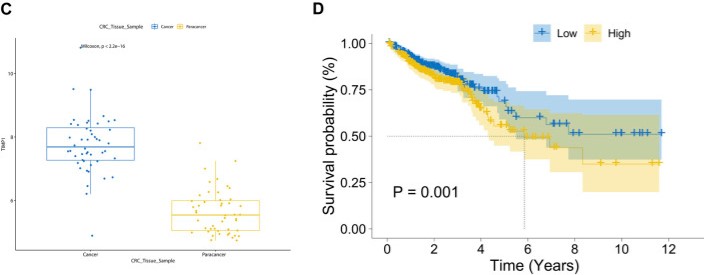
Fig1.Diagnostic and prognostic value analysis of TIMP1 in TCGA dataset.
(C) Expression of TIMP1 in cancer and adjacent normal tissue in the TCGA dataset, (D) Survival differences between high and low expression groups of TIMP1 in the TCGA dataset.
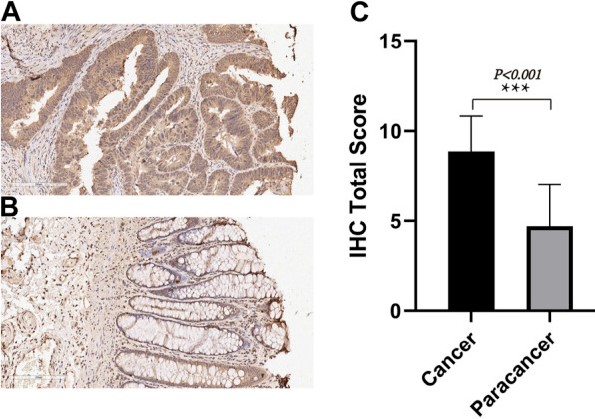
Fig2. TIMP1 expression in CRC tissues and adjacent normal tissues, (A) IHC staining of TIMP1 protein in CRC tissues, (B) IHC staining of TIMP1 protein in adjacent normal tissues, (C) Semi-quantitative analysis of TIMP1 protein in CRC tissues and adjacent normal tissues by IHC experiments.
Case 2: Ishihara R, et al. Int J Mol Sci. 2023.
In this study, the authors evaluated TIMP1 protein and mRNA levels in bone marrow (BM) plasma cells and assessed the effects of TIMP1 expression on fibroblast invasive capacity using three-dimensional spheroid cell invasion assays. The results suggested that MM-derived TIMP1 induces the invasive phenotype in fibroblasts and is involved in disease progression. Further studies are required to elucidate the specific roles of TIMP1 in MM and facilitate the development of novel therapies targeting the TIMP1 pathway.
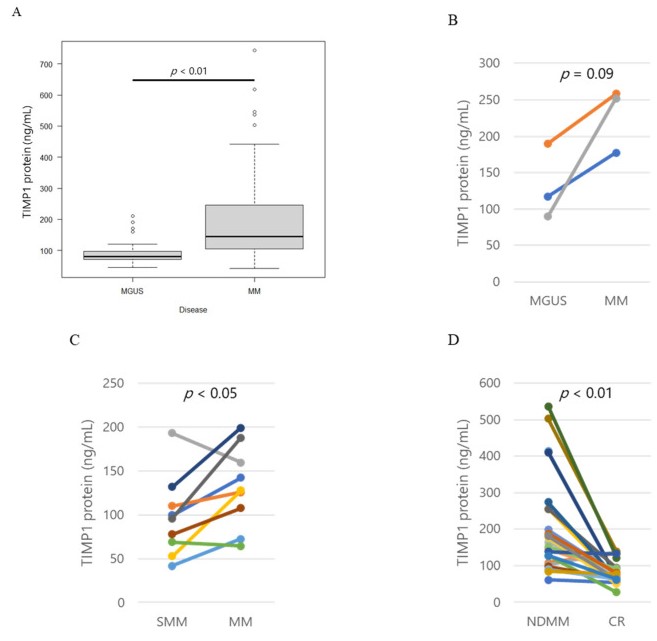
Fig1. Tissue inhibitor of metalloproteinase 1 (TIMP1) protein levels. (A) Box plot of TIMP1 protein levels in controls, patients with monoclonal gammopathy of undetermined significance (MGUS), and patients with multiple myeloma (MM). Pairwise comparisons of TIMP1 protein levels in patients with different disease statuses. (B) MGUS and MM, (C) smouldering myeloma (SMM) and MM, and (D) MM at newly diagnosis (NDMM) and at complete response (CR).
Case 3: Ma B, et al. Cancer Sci. 2022.
Although right-sided colorectal cancer (CRC) shows a worse prognosis than left-sided CRC, the underlying mechanism remains unclear. The researchers established patient-derived organoids (PDOs) from left- and right-sided CRCs and directly compared cell proliferation and invasion capability between them.
Their data suggest that TIMP1 is overexpressed in right-sided CRCs and promotes cell proliferation and invasion capability through the TIMP1/FAK/Akt pathway, leading to a poor prognosis. The TIMP1/FAK/Akt pathway can be a target for therapeutic agents in right-sided CRCs.
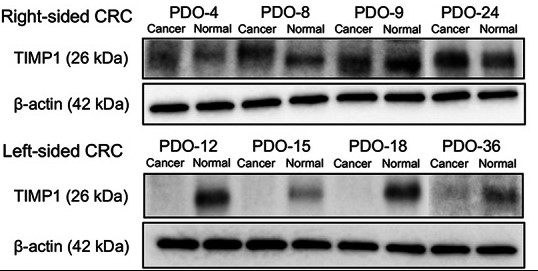
Fig1. Tissue inhibitor matrix metalloproteinase 1 (TIMP1) upregulation in right-sided cancer patient-derived organoids (PDOs). TIMP1 protein expression in right-sided and left-sided cancer and normal paired PDOs was evaluated by western blotting (n = 4 for each).
Quality Guarantee
High Purity
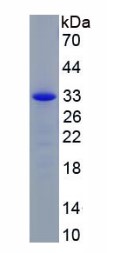
Fig1. SDS-PAGE (Cat. No.: TIMP1-409H)(Thr25-Ala207)
.
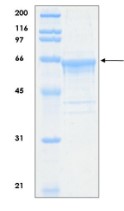
Fig1. SDS-PAGE (Cat. No.: TIMP1-001H)(Thr25-Ala207), Full-length TIMP1 Protein
Involved Pathway
TIMP1 involved in several pathways and played different roles in them. We selected most pathways TIMP1 participated on our site, such as HIF- signaling pathway, which may be useful for your reference. Also, other proteins which involved in the same pathway with TIMP1 were listed below. Creative BioMart supplied nearly all the proteins listed, you can search them on our site.
| Pathway Name | Pathway Related Protein |
|---|---|
| HIF- signaling pathway | VEGFA,IFNG,VHL,PFKL,IFNGR2,PDHB,MTOR,PDK1,LDHA,HK2 |
Protein Function
TIMP1 has several biochemical functions, for example, cytokine activity,growth factor activity,metal ion binding. Some of the functions are cooperated with other proteins, some of the functions could acted by TIMP1 itself. We selected most functions TIMP1 had, and list some proteins which have the same functions with TIMP1. You can find most of the proteins on our site.
| Function | Related Protein |
|---|---|
| protein binding | IL17RE,ARHGEF2,TFPT,SYNE3,RTKN,CTR9,PKP2,RARRES3,SALL4,LASP1 |
| growth factor activity | EGF,GDF3,LEFTY2,INHBA,HBEGFA,NDR1,NTF7,MSTNA,PDGFB,FGF7 |
| cytokine activity | BMP6,GPR19,Ifnz,IFNG1-2,IL34,KITLG,VEGFA,IFN-a,CER1,GDF7 |
| protease binding | TNFRSF10A,TYSND1,PEO1,CD28,A2M,ITGB3,BCL2,BDKRB2,SERPINA1A,OS9 |
| metal ion binding | ERI1,TRMT1L,ALKBH7,ANKMY2,DYTN,NEURL1B,PRICKLE1A,TDO2A,MMP14A,AMY1B |
| metalloendopeptidase inhibitor activity | RECK,LXN,SPOCK3,TIMP3,TIMP2A,FETUB,TIMP2B,NGF,WFIKKN2,WFIKKN1 |
Interacting Protein
TIMP1 has direct interactions with proteins and molecules. Those interactions were detected by several methods such as yeast two hybrid, co-IP, pull-down and so on. We selected proteins and molecules interacted with TIMP1 here. Most of them are supplied by our site. Hope this information will be useful for your research of TIMP1.
CD63;MMP9;RECQL5;EEF1B2;SUMO2;ECH1
Resources
Related Services
Related Products
References
- Krabben, A; Huizinga, TWJ; et al. Biomarkers for Radiographic Progression in Rheumatoid Arthritis. CURRENT PHARMACEUTICAL DESIGN 21:147-169(2015).
- Shi, M; Movius, J; et al. Cerebrospinal Fluid Peptides as Potential Parkinson Disease Biomarkers: A Staged Pipeline for Discovery and Validation. MOLECULAR & CELLULAR PROTEOMICS 14:544-555(2015).



